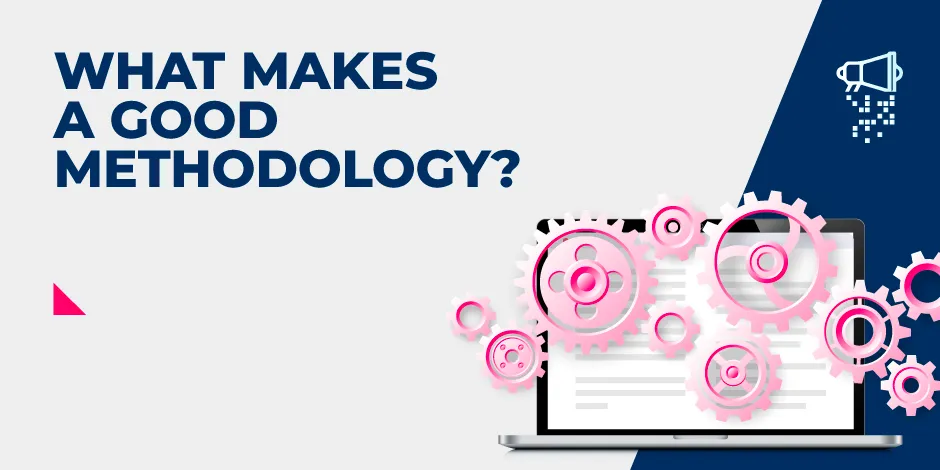

What Makes a Good Methodology?
Discover the key elements of effective methodology for your digital PR campaigns in our latest blog. With years of experience and experimentation in understanding what makes a good methodology, we’re the SEO agency to lead you through the process.
Along the way, we’ll provide examples of both good and bad approaches. With our unique insider tips, including insights from our expansive data team—the largest in the industry—we aim to help you create research methodologies that won’t leave your audience guessing.
What is a Methodology? (in digital PR)
According to Oxford Languages, a methodology is “a system of methods used in a particular area of study or activity”.
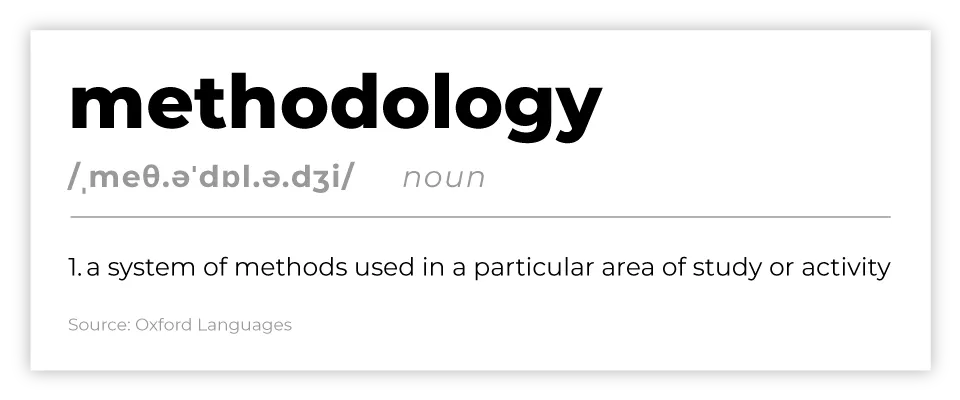
That's exactly why we whip up methodologies for all our digital PR campaigns. Whether it's a data-packed index piece or a light and fluffy social media hashtag campaign, we need to be crystal clear about why and how we're running things.
We're all about maintaining clarity, not only when it comes to the bigger picture of the highs and lows of digital PR but also the nitty-gritty: what is the purpose behind our digital PR efforts and how do we bring them to life? It's the secret sauce to being genuine leaders in the digital PR game!
Sean Rainforth, Content Specialist, comments:
“A good methodology should be like a recipe, a step-by-step guide on how something was completed, easily replicable so that anyone could pick it up and repeat the data collection without asking any questions”.
That's the crux of the matter. When we shoot out our digital PR campaign, we want the audience, journalists, whoever it may be, to grab that release and instantly get what it's all about. No back-and-forth is needed. We want to avoid the possibility of our release being ignored without getting the attention it deserves.
It's all about creating a press release that converts and makes that first impression stick! One way to do this is to include a good, reliable, and repeatable research methodology.
What Makes a Good Methodology?
Ultimately a digital PR campaign is only as strong as its methodology. A solid foundation is paramount; without it, our digital PR services risk appearing shaky and unbelievable, and may not command the attention they deserve.
In short, this is what makes a good methodology:
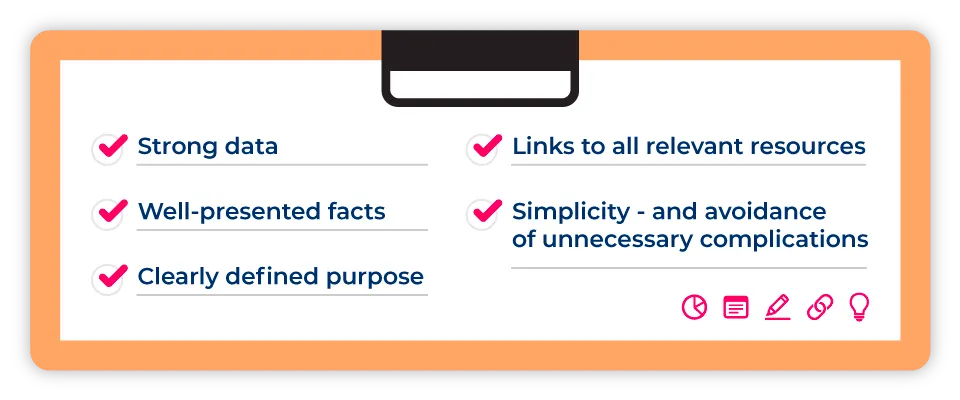
Let’s explore these key factors in more detail:
1. Clearly defined purpose
Planning a digital PR campaign is an important part of the process as it provides a solid framework for building the methodology. Start by clearly defining the purpose of the campaign and the supporting data.
“Clearly defined campaign objectives are fundamental. This guides you in choosing the right mix of data sources. A good methodology comes from strong research in the campaign idea to effectively get the data required, knowing what you need before collecting and how you intend to use it saves time and leads to better analysis.” — Paul Lapham, Data Insights Manager
2. Strong data
When creating data-driven digital PR campaigns to earn backlinks, we must assess the strength of the data sources being used. Data for the campaign should not be arbitrary; instead, look for reliable sources such as official data, lists, or authoritative studies.
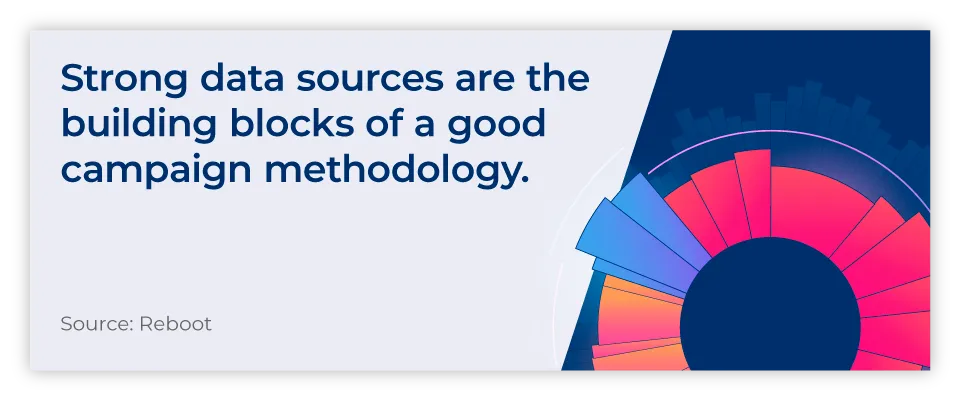
Paul continues: “Consider both primary data like Gov.uk, surveys, and polls for insights, and secondary data from public datasets or Freedom of Information (FOI) requests for broader context when appropriate.”
Daniel Smiech, one of our Data Analysts, adds: “Using industry-standard data handling, collection, and analysis tools, such as Python, can boost the insights you make and allow you to extract more from your data.”
For instance, when creating a campaign on the scariest films, use reputable sources like IMDb's top 100 scariest films to establish a strong seed list rather than simply picking your favourite movies out of a hat. This gives your methodology a more solid foundation, showcasing substantial and authoritative data sources.
3. Well-presented facts
Articulate the research findings clearly and concisely in the methodology. Provide a step-by-step chronological breakdown, indicating when the analysis occurred and specifying timeframes. Emphasise recent data to capture the attention of journalists seeking the latest insights.
“A good methodology should outline exactly what was done, how it was done, and any nuances that were taken into consideration (i.e. any problems that needed to be navigated and how they were overcome). Plus the equipment (i.e. sources/tools used) at each step of the process.” — Sean Rainforth, Content Specialist
4. Links to all relevant resources
Make sure all your links to data and resources are in place and correctly cited. This is like the holy grail — you can't skip it.
Including these links not only makes your method and campaign legit but also grounds the PR campaign in tangible tools and data sources.
Learn more about the best sources to use for digital PR campaigns.
5. Simplicity (check if it's journalist-ready)
Take a step back and ask yourself: Does my methodology give journalists everything they need to back up their article? Does it add value to the campaign and the audience? But above all, make sure it’s written as simply as possible — something anyone could pick up and run with, with no mystery involved.
Extra things to think about:
-
Are your assumptions on point? Do the assumptions in your methodology make sense?
-
Does it prove your point? Is your methodology making the point you want to make?
-
Can outsiders get it? Would someone who knows zero about your campaign still get what you're discussing in the methodology?
By nailing these points, you're not just beefing up your methodology but increasing the chances of journalists picking up the story you’re pitching. This often leads to successful PR campaigns, mirroring the outcomes showcased in our case studies.
Good Research Methodology Examples
When thinking about what to include in a methodology, it's pretty straightforward: it's about mixing purpose and precision. Every piece of data, every fact, helps answer any questions people might have about your campaign or study. Let's check out some examples that demonstrate just that.
Example 1:
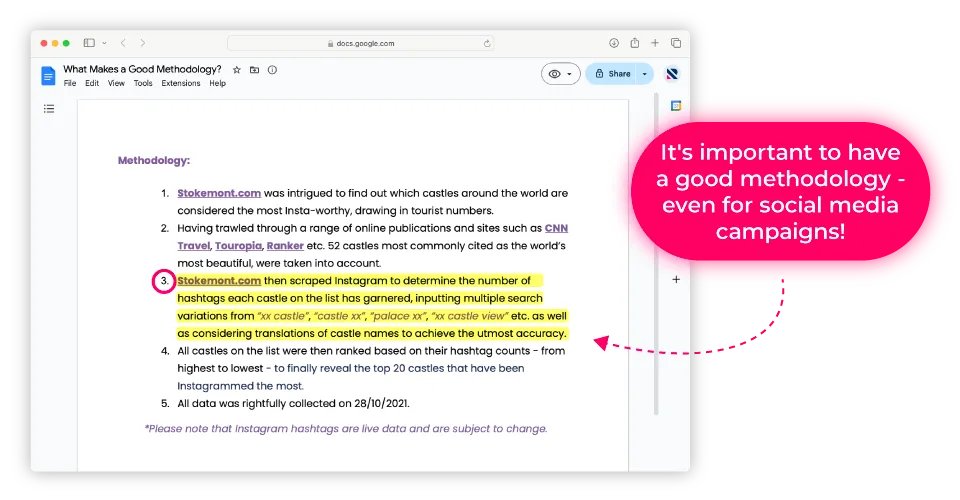
This example shows why it's important to have a clear plan, even for fun and light-hearted projects like social media campaigns. In our example, we started with Instagram but went beyond the surface.
We collected finer details from the platform, such as multiple search options for each castle. This enabled us to achieve the highest level of data accuracy. These apparently simple search volumes offer a deeper understanding of the overall data. Therefore, it was important to include this in the methodology, which we highlight in point 3.
We should always explain how we came up with our ideas, no matter what we're creating. Failing to do so puts our authority on the subject at risk.
Example 2:
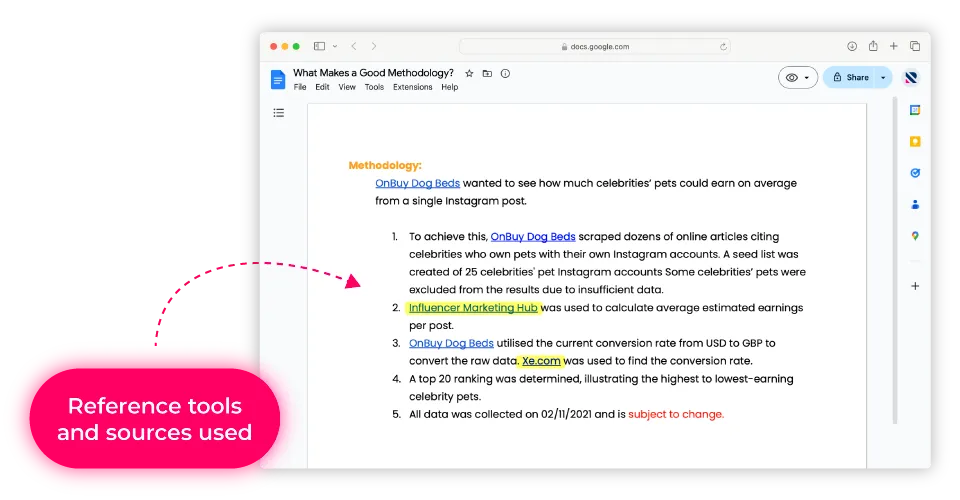
This example is great because it clearly references and links to all sources, including the client's inner category page, which adds extra value to the campaign's goals.
We want our audience to easily credit each part of our digital PR campaign, so we include clickable links to external sources and tools. This allows our audience to explore further on their own if needed, eliminating the need for them to contact us with questions.
Example 3:
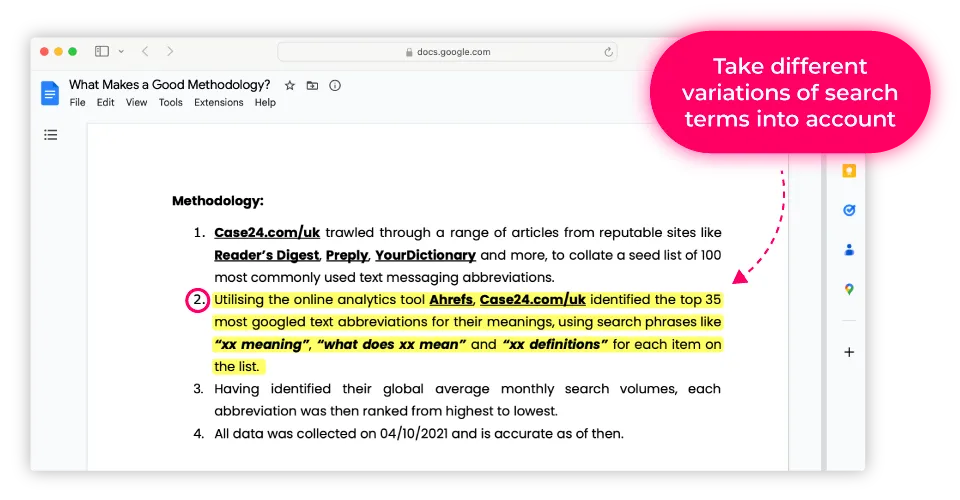
Including variations in a campaign's methodology not only boosts its accuracy and scope but also demonstrates our dedication to our data. We constantly strive to extract the most value from it. Simply stating that we identified the 35 most googled text abbreviations isn't enough. External sources would be left wondering how those 35 were chosen.
Example 4:
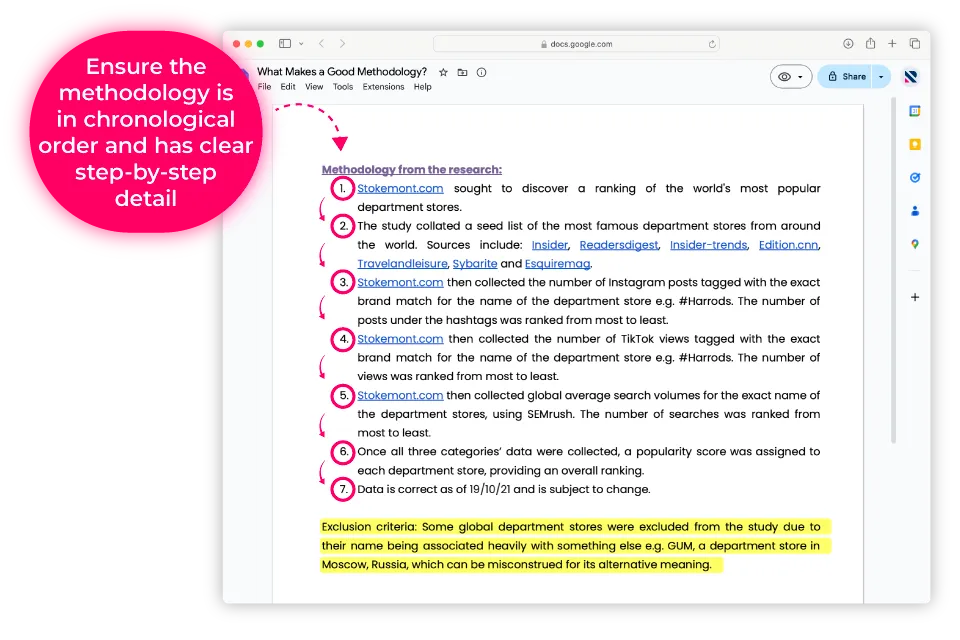
This example shows how a good methodology should be laid out step-by-step and in chronological order. Anyone trying to replicate it externally can easily do so by following the points from one to seven.
It also demonstrates the importance of including exclusion criteria. Just like incorporating variations, including exclusions reinforces our accuracy. It helps explain any deviations or anomalies in our data, saving journalists or audiences from having to ask us questions later.
Example of a Bad Research Methodology
When it comes to what should be avoided in research methodologies, sometimes, it's quite easy to miss the mark — maybe the purpose or goal just isn't clear enough.
However, there are more serious issues that are harder to forgive. The sequence of events might be muddled, or details like exact figures and timestamps could be missing. Even worse, there might not be an explanation for why certain data is included in the first place.
Let's break down a "bad" research methodology example. We'll explore why it falls short compared to good and repeatable research methodologies.
“Bad” Methodology Example:
Below, we have an example of a methodology that we consider to be "bad". Why has it been crowned with this title? Let’s find out.
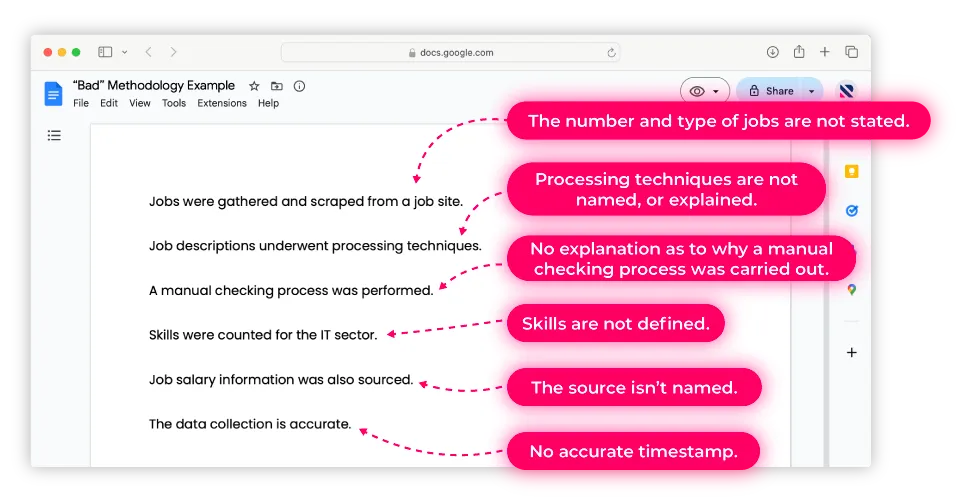
This research methodology is considered poor for several reasons:
-
Lack of clear purpose or goal for the campaign, making its direction unclear.
-
The absence of numbered steps makes it challenging to follow the process step-by-step.
-
No defined dataset or explanation for the chosen techniques or processes, leaving readers questioning their relevance.
-
The absence of named sources or linked references diminishes the credibility of the methodology.
-
Lack of an accurate timestamp, failing to provide context or relevance to the timeline of the research.
Here’s how this research methodology should look:
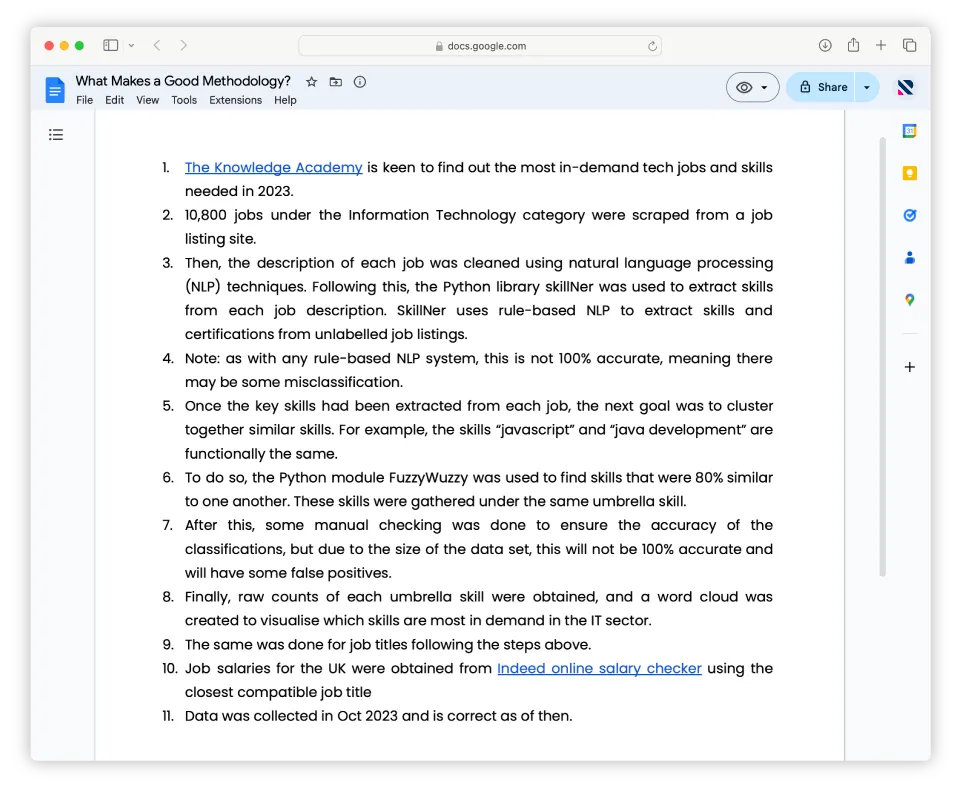
This methodology adheres to the key principles we've highlighted in this blog. It includes a clearly defined purpose (1), and presents strong data and facts in a well-organised manner, with references and links provided where needed. Each step is written clearly to ensure understanding for all audiences, even those without knowledge of Python!
How to Write a Good Methodology: Reboot Team Tips
Jack Clifford, Senior Digital PR Exec:
“A good methodology should start with a clear description of the research question (purpose of the campaign). It should be something that a reader or journalist with likely no data knowledge can understand (so don’t overcomplicate it!)
It’s also beneficial to list any disclaimers, such as ‘up-to-date data for X couldn’t be found, therefore X data was used’ so journalists don’t spot any inaccuracies.”
Sebastian Drinnan, Data Analyst:
“Methodologies should be detailed enough so that another analyst can replicate the data collection for a similar campaign or refresh. At the root, it’s about efficiency, balancing ease of data collection with the value it would provide to the campaign.”
Laura Solloway, Senior Digital PR Manager:
“A good methodology needs to anticipate any questions a journalist might have and answer them. If you are ever unsure that your methodology meets this mark, try sending it to someone who's never seen it (or the accompanying PR campaign) before and ask them if it's clear. If it is, this is a good sign of a strong methodology.”
For more information about our expertise and PR services, reach out to us today.